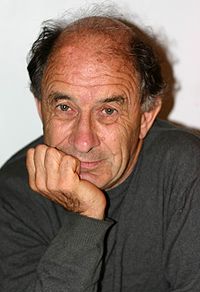Vladimir Igorevich Arnold (or Arnol'd; Russian: Влади́мир И́горевич Арно́льд, IPA: [vlɐˈdʲimʲɪr ˈiɡərʲɪvʲɪtɕ ɐrˈnolʲt]; 12 June 1937 – 3 June 2010)[1][3][4] was a Soviet and Russian mathematician. He is best known for the Kolmogorov–Arnold–Moser theorem regarding the stability of integrable systems, and contributed to several areas, including geometrical theory of dynamical systems, algebra, catastrophe theory, topology, real algebraic geometry, symplectic geometry, differential equations, classical mechanics, differential-geometric approach to hydrodynamics, geometric analysis and singularity theory, including posing the ADE classification problem.
His first main result was the solution of Hilbert's thirteenth problem in 1957 at the age of 19. He co-founded three new branches of mathematics: topological Galois theory (with his student Askold Khovanskii), symplectic topology and KAM theory.
Arnold was also known as a popularizer of mathematics. Through his lectures, seminars, and as the author of several textbooks (such as Mathematical Methods of Classical Mechanics) and popular mathematics books, he influenced many mathematicians and physicists.[5][6] Many of his books were translated into English. His views on education were particularly opposed to those of Bourbaki.
- ^ a b Khesin, Boris; Tabachnikov, Sergei (2018). "Vladimir Igorevich Arnold. 12 June 1937 – 3 June 2010". Biographical Memoirs of Fellows of the Royal Society. 64: 7–26. doi:10.1098/rsbm.2017.0016. ISSN 0080-4606.
- ^ Cite error: The named reference
mathgenewas invoked but never defined (see the help page). - ^ Mort d'un grand mathématicien russe, AFP (Le Figaro)
- ^ Cite error: The named reference
obituarywas invoked but never defined (see the help page). - ^ O'Connor, John J.; Robertson, Edmund F., "Vladimir Arnold", MacTutor History of Mathematics Archive, University of St Andrews
- ^ Bartocci, Claudio; Betti, Renato; Guerraggio, Angelo; Lucchetti, Roberto; Williams, Kim (2010). Mathematical Lives: Protagonists of the Twentieth Century From Hilbert to Wiles. Springer. p. 211. ISBN 9783642136061.
